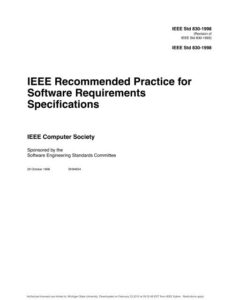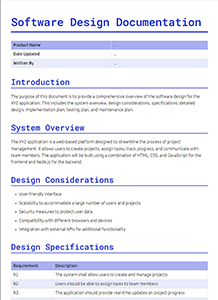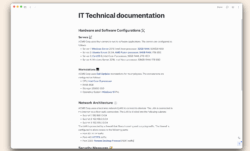In the realm of software development, thorough testing is paramount to ensuring quality and reliability. But, testing isn’t just about running some code and hoping for the best. It’s a structured process, and a critical part of that process is documentation. Without proper documentation, you’re essentially flying blind, making it difficult to track progress, identify issues, and maintain the software over time. This is where the ieee standard for software test documentation template becomes incredibly valuable.
Think of the ieee standard for software test documentation template as a blueprint for your testing efforts. It provides a framework for creating clear, concise, and consistent documentation that covers all aspects of the testing process, from planning and design to execution and reporting. Using a standardized template ensures that everyone on the team is on the same page, making communication easier and reducing the risk of misunderstandings.
So, whether you’re a seasoned software tester or just starting out, understanding and implementing the ieee standard for software test documentation template can significantly improve the effectiveness of your testing efforts. It’s not just about following a set of rules; it’s about creating a valuable resource that will help you deliver high-quality software that meets your users’ needs. Let’s dive deeper into what this standard entails and how you can use it to your advantage.
Understanding the IEEE 829 Standard for Software Test Documentation
The IEEE 829 standard, formally known as the IEEE Standard for Software and System Test Documentation, is a widely recognized framework that defines the format and content of documents used in software testing. It provides a comprehensive set of guidelines for creating essential test documents, ensuring consistency and clarity across the testing lifecycle. It’s like having a universal language for test documentation, making it easier for different teams and organizations to collaborate and understand each other’s work.
At its core, the IEEE 829 standard defines a set of specific document templates, each designed to capture different aspects of the testing process. These templates include the Test Plan, which outlines the scope, approach, resources, and schedule of the testing activities; the Test Design Specification, which describes the features to be tested and the test cases to be used; the Test Case Specification, which details the individual steps involved in each test case; the Test Procedure Specification, which provides step-by-step instructions for executing the test cases; the Test Item Transmittal Report, which documents the release of software for testing; the Test Log, which records the results of the test execution; the Test Incident Report, which describes any problems or anomalies encountered during testing; and the Test Summary Report, which summarizes the overall testing effort and its results.
The beauty of the IEEE 829 standard lies in its flexibility. While it provides a structured framework, it doesn’t prescribe a rigid process. You can adapt the templates and guidelines to fit the specific needs of your project and organization. For example, you might choose to combine some of the documents, or you might add additional sections to address specific requirements. The key is to ensure that your documentation is clear, concise, and complete, and that it effectively communicates the information needed to understand and evaluate the testing process.
Implementing the IEEE 829 standard may seem daunting at first, but the benefits are well worth the effort. By using a standardized approach to test documentation, you can improve communication, reduce errors, and increase the efficiency of your testing efforts. It also makes it easier to track progress, identify issues, and maintain the software over time. Moreover, having well-documented test processes is essential for compliance with industry regulations and standards.
Ultimately, the goal of the IEEE 829 standard is to promote high-quality software by providing a framework for effective test documentation. By following this standard, you can ensure that your testing efforts are well-planned, well-executed, and well-documented, leading to more reliable and robust software. Understanding the ieee standard for software test documentation template is an important step.
Benefits of Using an IEEE Standard for Software Test Documentation Template
Adopting an ieee standard for software test documentation template brings a multitude of advantages to your software development lifecycle. One of the primary benefits is enhanced communication among team members. With a standardized format, everyone understands where to find specific information, reducing ambiguity and misinterpretations. This streamlines collaboration and ensures that everyone is on the same page regarding testing progress, issues, and results.
Another significant advantage is improved test coverage. By following the structured approach of the IEEE standard, you are more likely to identify all the necessary test cases and ensure that all critical functionalities are thoroughly tested. This reduces the risk of defects slipping through to production and improves the overall quality of the software.
Furthermore, using an ieee standard for software test documentation template enhances traceability. The documented test cases and results can be easily linked to requirements, design specifications, and code modules. This traceability allows you to quickly identify the root cause of defects and assess the impact of changes. It also simplifies the process of demonstrating compliance with industry regulations and standards.
The benefits extend beyond the immediate testing phase. Well-documented test processes serve as valuable knowledge repositories. They provide a historical record of testing activities, which can be used to improve future testing efforts and train new team members. The documentation can also be used to support software maintenance and upgrades, as it provides a clear understanding of how the software was tested and what types of defects were encountered.
Moreover, a standardized test documentation template can save time and effort in the long run. While the initial setup may require some investment, the consistent format and clear guidelines reduce the need for rework and clarification. This allows testers to focus on the actual testing activities, rather than spending time formatting documents and searching for information. In essence, the ieee standard for software test documentation template is a valuable asset that contributes to a more efficient and effective software development process, leading to higher-quality software and increased customer satisfaction.
Furthermore, by implementing an ieee standard for software test documentation template, you foster a culture of quality and accountability within your team. This ultimately leads to improved software quality, reduced development costs, and enhanced customer satisfaction. It demonstrates a commitment to best practices and a dedication to delivering reliable and robust software.
Ultimately, effective software testing boils down to meticulous planning and execution, coupled with clear and comprehensive documentation. Utilizing the ieee standard for software test documentation template is a key ingredient for a well-managed testing process.



